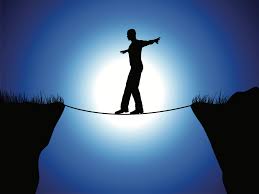|
A Blog about Sensory Processing Sensitivity from the Worldview of a High Sensing Male
Pee-wee: There's a lotta things about me you don't know anything about, Dottie. Things you wouldn't understand. Things you couldn't understand. Things you shouldn't understand. Dottie: I don't understand. Pee-wee: You don't wanna get mixed up with a guy like me. I'm a loner, Dottie. A rebel. So long, Dott. From: Pee-wee’s Big Adventure. The idea of thrill-seeking highly sensitive people may seem a bit out of character. The notion of nice, quiet, pensive, peace-loving individuals, taking off on wild adventures as novelty seeking daredevils just doesn’t match up with the stereotype of HSPs. Believe or not, there is a subset of HSPs, that do fit that profile and are high sensation seeking (HSS) folks or to spell it out, High Sensation Seeking Highly Sensitive People HSS/HSP. Dr. Tracy Cooper reports that there is about thirty percent of the HSP population that fits this label. Most of them are male. There are four primary traits that high sensation seeking people display. One, they are thrill and adventure seekers, i.e., drawn to adrenaline-pumping risky sports and activities like mountain climbing, bungee jumping, motocross, etc. These are the kind of activities you would most expect from a daredevil. Two, they are experience seekers – looking for novel mind-bending mental sensations-- think of psychoactive substances or sensory bending experiences. Three, they display moments of disinhibition, mostly in the realm of social or sexual activities (wild parties, inebriation, or multiple sexual partners) Hence, a relaxation of social boundaries and the willingness to cross them. Finally, they are prone to boredom susceptibility, the tendency towards aversion of repetitious activity and seeking novelty as stimulation. HSS/HSP’s tend to fall mainly in the last three traits, granted, with some caveats. In describing this trait, especially in HSPs, it might seem that we could describe this as reckless behavior, uncharacteristic of traditional HSP traits. However, because of the dual nature of HSS/HSP individuals, they tend not to be at the extremes. This duality presents many internal conflicts working both sides of the caution versus novelty endpoints. This conflict is a classic one foot on the gas, one on the brake scenario, which I suppose creates some novel forward motion, but doesn’t test the boundaries of thrill-seeking to its limits. For most HSS/HSPs, high sensation seeking is about the novelty of the experience. Changing the landscape for a new view seems a bit more modest and a controlled method of allowing for a taste of what might seem dangerous, without risking life or limb. We HSPs tend to have a more pronounced Behavioral Inhibition System. Thus brakes get applied when the ride gets too dangerous. Although some of this behavior does border on impulsivity (taken from my own experience), it is not unguided by a more cautious retracting or overriding behavior reigning in, when the drift is too uncomfortable. What is the balance between walking the high wire and resting safely in the net? How much and what type of sensation is necessary to overtake the underlying boredom of being quiet and reflective? Since most HSPs are introverted, seems a far cry from living in the cocoon of the internal world, which is already being bombarded by a greater amount of sensory data. Why fetch more sensation, even when bored, if the idea is to overstimulate? It seems almost a cruel hoax to possess these two opposing characteristics. One pushing inward, one pulling outward, one processing experience, one seeking experience, teasing the limits of an already sensitive system. Can this sensation seeking be controlled; throttled pleasure, with none of the irresponsibility of reckless and dangerous impulse? It seems at times to be like an unconscious draw to seek overstimulation, an addiction to adrenaline, however modest, only to offset quickly with reflection and solitude. And, what of this cycle? To what extreme can it go? Are some of us HSPs, sensation seekers, walking as it were without a net? Making bad decisions, knowing the consequences, yet yielding to some inner drive for increased sensation. Like diving headlong into a freezing pool, only to jump out and run back inside by the crackling fire. An odd balance of fire and ice, throttling between the two, just enough to keep the fire hot and the ice cold. Can any of this be self-destructive? Is the impulsivity of taking risks for the novel sensation balanced by a keen sense of risk perception? Are HSS/HSPs more likely to access the reward/gamble ratio and to step out of a typical HSP cautionary personality to seek novel experiences, just to keep from being bored? The answer is yes and no. Perhaps, there is a deeper drive to create, that motivates seeking out novel experience to be able to fashion something new and useful. The motivator is boredom; the outcome is creativity with reward and stimulation. With a third of the HSP population showing this trait of novelty seeking – it certainly would explain the high level of creativity the emerges from the HSP community. To be creative, one must be willing to seek new ways of looking at things, to put parts together in unusual ways and to be willing to risk criticism for your creations. The reward of success is a big rush of dopamine for having braved and crafted one’s indulgences. The added splash of adrenaline doesn’t hurt either. How do you tell if you are an HSS/HSP? Yes, there is a test for that, too. Dr. Elaine Aron has constructed a test that was designed for HSPs to determine if you are a high sensation seeking individual. Here’s the link: https://hsperson.com/test/high-sensation-seeking-test/ . I scored high enough on the test to be considered an HSS/HSP. My experiences as an HSS/HSP follow a familiar pattern. Always seeking some secure situation, a job, a marriage, a relationship, a life, then abruptly leaving, almost at a whim, when boredom kicks in. Then being lost for a period, seeking, looking sometimes recklessly, then finding a new novel situation to anchor me. Only to leave again, a drifter on the run. Sometimes, doing stupid things or taking risky gambles, zigging and zagging off the path gets added in the mix, then getting comfortable for stretches. Then, again, boredom sets in, creating changes that have consequences and require remediation. The boredom is not what you might think of as boredom. It’s unsettling, restless, not like a little kid or a too bright child unable to find the creative ability to stay active. It’s like an internal clock that says, “enough, time to move on.” A prompting, a calling to change venues. I hardly understand it, others never understand it. A neutral, unemotional epiphany that says it’s time to seek other sensations. I’d like to think that this process is all trending upward, a giant learning process, like climbing the tread of larger than life wheel. But, who knows? In the end, it is always looking for that balance between boredom and overstimulation. A good, and sensitive man, who sometimes makes perplexing decisions. Ray Kinsella: I'm 36 years old, I love my family, I love baseball, and I'm about to become a farmer. But until I heard the voice, I'd never done a crazy thing in my whole life. From: Field of Dreams. References:
0 Comments
Leave a Reply. |
AuthorBill Allen currently lives in Bend, Oregon. He is a certified hypnotist and brain training coach at BrainPilots.com. He believes that male sensitivity is not so rare, but it can be confounding for most males living in a culture of masculine insensitivity which teaches boys and men to disconnect from their feelings and emotions. His intent is to use this blog to chronicle his personal journey and share with others. Archives
July 2024
Categories
All
|


 RSS Feed
RSS Feed
